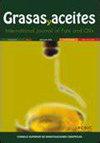落簇强度影响榛子的生物活性成分和脂肪酸组成
IF 1.1
4区 农林科学
Q4 CHEMISTRY, APPLIED
引用次数: 3
摘要
本研究旨在确定簇落强度如何影响Tombul、Palaz和Kalınkara榛子品种的坚果性状、生物活性化合物和脂肪酸组成。聚类下降显著影响坚果的生物活性化合物和脂肪酸组成,而不影响坚果的性状。随着丛落强度的增加,所有品种的坚果性状和生物活性化合物都有所增加。较强的簇落强度决定了总酚、总黄酮和抗氧化活性最高。除Kalınkara品种外,在轻微的簇落强度下,检测到少量的亚油酸,而高含量的油酸和硬脂酸。随着簇落强度的增加,棕榈酸含量增加。主成分分析表明,轻度和中度下降强度通常与籽粒长度、油酸、亚油酸、硬脂酸、棕榈油酸、11-二十碳烯酸和花生四烯酸有关。相反,强强度与坚果和内核重量、内核比例、内核宽度、内核厚度、内核大小、生物活性化合物和棕榈酸有关。结果,对人类健康重要的生物活性化合物和脂肪酸组成受到簇落强度的显著影响。本文章由计算机程序翻译,如有差异,请以英文原文为准。
The intensity of the cluster drop affects the bioactive compounds and fatty acid composition in hazelnuts
This study was conducted to determine how the intensity of the cluster drop effects nut traits, bioactive compounds, and fatty acid composition in Tombul, Palaz and Kalınkara hazelnut cultivars. The cluster drop significantly affected bioactive compounds and fatty acid composition while it did not affect the traits of the nuts. As cluster drop intensity increased, nut traits and bioactive compounds in all cultivars increased. Strong cluster drop intensity determined the highest total phenolics, total flavonoids, and antioxidant activity. Except for the Kalınkara cultivar, a low amount of linoleic acid was detected while high amounts of oleic and stearic acid were determined in slight cluster drop intensity. As cluster drop intensity increased, palmitic acid increased. Principal component analysis showed that the slight and intermediate drop intensity were generally associated with kernel length, oleic, linoleic, stearic, palmitoleic, 11-eicosenoic and arachidic acids. In contrast, strong intensity was associated with nut and kernel weight, kernel ratio, kernel width, kernel thickness, kernel size, bioactive compounds, and palmitic acid. As a result, the bioactive compounds and fatty acid composition, which are important for human health, was significantly affected by cluster drop intensity.
求助全文
通过发布文献求助,成功后即可免费获取论文全文。
去求助
来源期刊

Grasas y Aceites
工程技术-食品科技
CiteScore
2.50
自引率
0.00%
发文量
50
审稿时长
3 months
期刊介绍:
Grasas y Aceites is a peer-reviewed journal devoted to the publication of original articles concerning the broad field of lipids, especially edible fats and oils from different origins, including non acyl lipids from microbial origin relevant to the food industry. It publishes full research articles, research notes, reviews as well as information on references, patents, and books.
Grasas y Aceites publishes original articles on basic or practical research, as well as review articles on lipid related topics in food science and technology, biology, (bio)chemistry, medical science, nutrition, (bio)technology, processing and engineering. Topics at the interface of basic research and applications are encouraged. Manuscripts related to by-products from the oil industry and the handling and treatment of the wastewaters are also welcomed.
Topics of special interest to Grasas y Aceites are:
-Lipid analysis, including sensory analysis
-Oleochemistry, including lipase modified lipids
-Biochemistry and molecular biology of lipids, including genetically modified oil crops and micro-organisms
-Lipids in health and disease, including functional foods and clinical studies
-Technical aspects of oil extraction and refining
-Processing and storage of oleaginous fruit, especially olive pickling
-Agricultural practices in oil crops, when affecting oil yield or quality
 求助内容:
求助内容: 应助结果提醒方式:
应助结果提醒方式:


